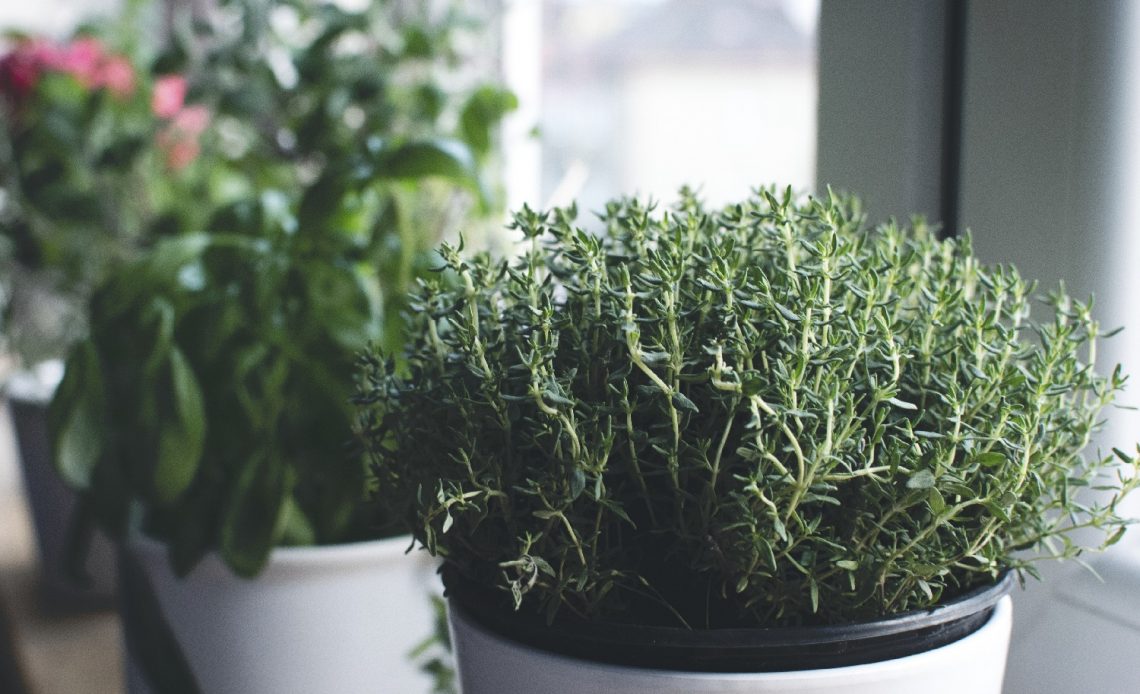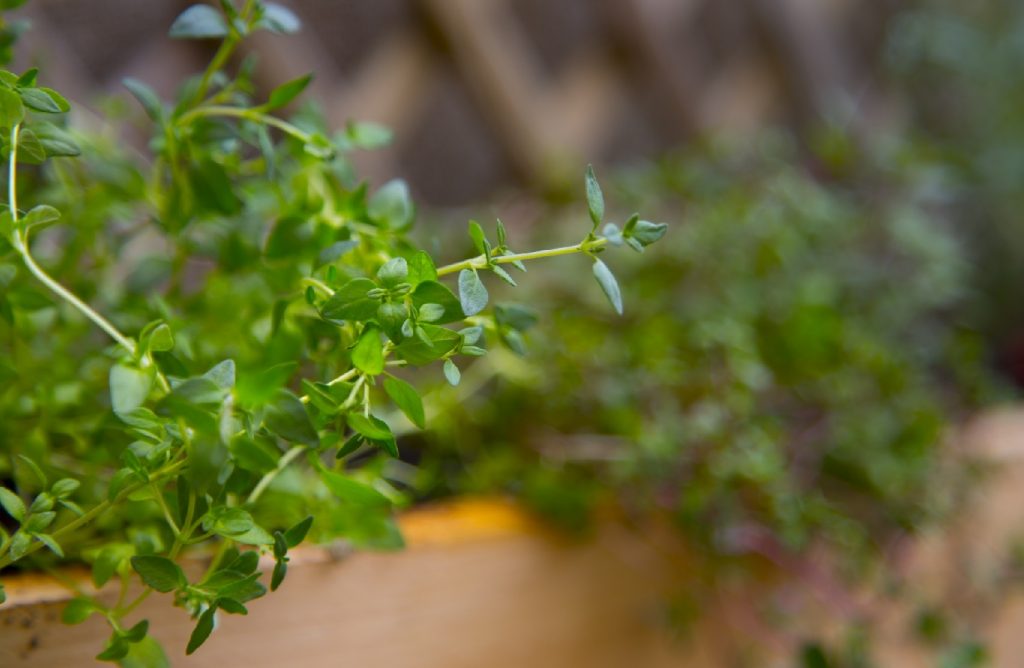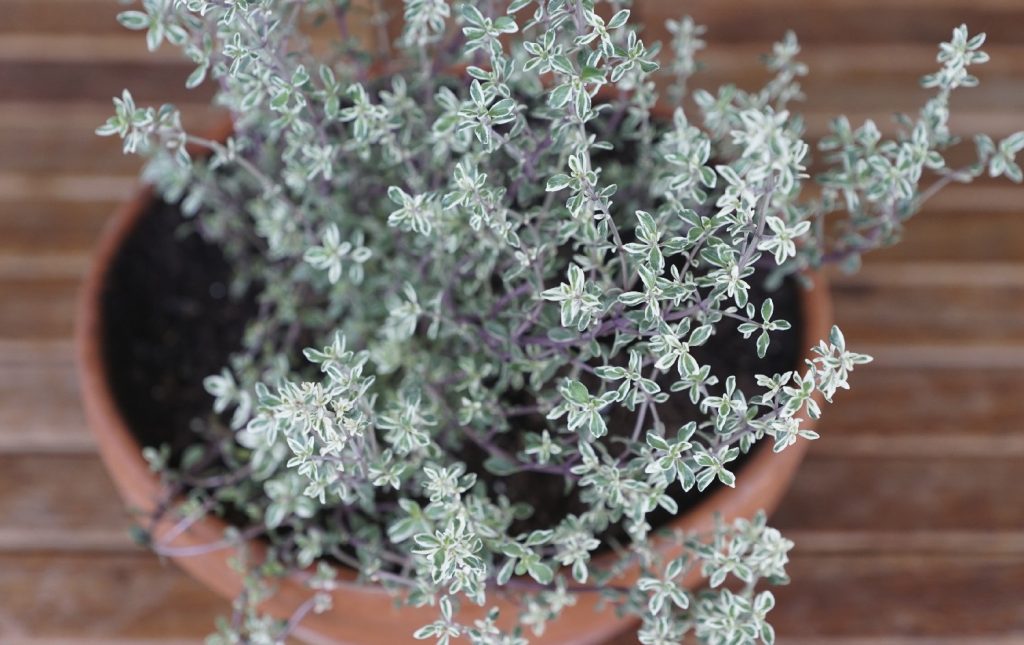

We’re here to help! Wild Yards is a completely free website that is 100% dedicated to helping you create a wildlife-friendly, sustainable yard. Read more
WildYards is reader-supported. When you buy a product through a link on our site, we may earn a comission. Every product is independently selected by our (obsessive) editors and our reviews are unbiased and objective. Read more about our mission or our privacy policy.
If you’re new to gardening and you want to expand your knowledge by learning how to grow plants from cuttings, thyme is the perfect one to start with. Thyme is so easy to grow and it takes root so rapidly that most people consider it invasive. Fortunately, it’s easy to keep this plant under control by shearing it back. The next time you trim your thyme plants, keep a few pieces aside so you can use them to learn how to grow thyme from cuttings.
Propagating thyme from cuttings is a straightforward process. Simply take your thyme cutting, dip it in rooting hormone, and place it in a small pot filled with well-drained soil. Getting thyme to take root is easy, but choosing which stems make the best cuttings takes some practice. Fortunately, this hardy plant is forgiving if you make any mistakes as you learn how to grow thyme from cuttings.
Is growing thyme from cuttings easier than growing it from seeds?
Thyme seeds germinate in 2 to 3 weeks, which makes them slow growing compared to other plants like tomatoes, which germinate in 6 to 11 days. Growing thyme from seeds can be frustrating because they have a low germination rate. Many gardeners sow thyme seeds near their blueberry plants to be grown as companions, only to be frustrated when only one or two thyme plants sprout.
Fortunately, thyme is easy to grow from cuttings. You can find mature thyme plants at most nurseries, especially those that specialize in fruits and vegetables. And you can take multiple cuttings from a grown plant at once. Growing thyme cuttings results in more useable plants than growing thyme from seeds, making this the best method of propagating thyme.
How to grow thyme from cuttings
Growing plants from cuttings can seem like a daunting task. What if your first cutting doesn’t root and you need to take another one, will it hurt the thyme to keep trimming it? No, not at all! Thyme is a tough little herb that can stand up to regular clippings. After all, many backyard gardeners use fresh thyme in their cooking, harvesting sprigs whenever a recipe calls for them. So you can gather a handful of cuttings from thyme without doing any damage.
To propagate thyme from cuttings, start by using sharp scissors or a pair of clippers to take a 2-inch sprig from the plant. The clipping should have multiple sets of leaves and should include leaf nodes where new leaves are beginning to emerge.
Once clipped, remove the bottommost 2 to 3 sets of leaves, dip the cut end into a small container of root hormone, and plant the cutting in a seedling pot in well-drained potting soil.

How to start thyme cuttings in water
If you’d like to watch your thyme cuttings grow, you can keep them in a jar of water until the roots develop. This process is a little different than placing the cuttings directly in the soil, but it’s just as easy. And this makes for a fun activity for kids.
Simply take a thyme cutting and prepare it as you would for potting. But instead of placing it in the dirt, set it in a clear glass jar in 2 to 3 inches of water. You want to cover ¾ of the bare stem at the bottom and leave the top of the plant exposed. Place the cutting on a sunny windowsill, sit back, and watch.
If you’d like to speed things along, you can add a tiny pinch of root hormone to the water to stimulate growth. If the water becomes cloudy, change it out. It may take your thyme cutting a few weeks to grow new roots, but most thyme cuttings start rooting after just one week. Once several roots have developed, you can transfer the cutting to a small pot.
How can you decide which thyme branches are best for cutting?
Choosing the right thyme branches and clipping them at the proper point in the thyme’s growing cycle is critical to achieving success. This requires having a healthy mature thyme plant on hand so you can observe its growth.
Thyme stems become woody with age, and it’s very difficult to get woody stems to take root, so avoid choosing these branches. But it’s just as important to avoid clipping young stems. While new growth is tender and green, these stems don’t work well for cuttings, either, because they’re too weak to survive on their own.
Look for stems that have matured but have not become woody. These branches will be a darker green than the thyme plant’s new growth, which is bright yellow-green by comparison. You’ll find them growing between the older woody growth at the base of the plant and the newer foliage at the top.
You should also avoid taking cuttings from your thyme when it’s blooming. Trimming the plant shortly before and during its blooming period in spring inhibits flower production. Besides, these clippings are poorly suited to propagation as budding stems can’t support flower production and root growth at the same time.

What’s the best soil to grow your thyme cuttings in?
If you’re just learning how to grow thyme from cuttings, here’s a tip: don’t plant them in traditional potting soil. It’s too heavy. Regular potting soil is nutrient-rich and designed to retain water. It works well for hydrangeas and other moisture-loving ornamentals. But it can make propagating herbs like thyme difficult because these plants need nutrient-poor soils that are well-drained to survive.
You’ll need to amend your potting soil with sand or cactus potting soil to ensure it’s porous enough to allow water to escape. Adding some gravel to the mix can further aid in drainage. If your native soil is sandy, you can add some to a small pot for your thyme cuttings. Otherwise, consider mixing up our lavender potting soil, which works well with thyme, too.
Thyme performs best in soils that range in pH from 5.5 to 7.5. Any higher or lower than this will result in unhealthy thyme, and it may kill the plant altogether. Use a soil tester to check your soil’s pH and modify it accordingly to improve your thyme cutting’s chances of survival.
How should you care for your thyme cuttings?
Mature thyme plants thrive in full sun. But new thyme cuttings are weak and vulnerable, so they’ll need some special care while they take root. Ensure your cuttings are in a location where they can receive morning sun and afternoon shade. Too much heat can cause cuttings to become wilted.
Water the cuttings regularly, but don’t let the soil become soggy. It’s okay if the dirt dries out completely. Thyme doesn’t like to sit in wet soil. But don’t let your cuttings stay dry for too long. Water them a bit every morning, and check their condition throughout the day. If they wilt in the afternoon, even in shade, and they don’t recover by evening when things cool off, give them more water.
Finally, make sure to keep your newly potted cuttings where animals can’t get to them. Armadillos, rabbits, foxes, squirrels, and other pesky critters will uproot potted plants in search of bugs. Disturbing the roots of your new cuttings as they develop will kill them, so keep them where they won’t get knocked over.
When can you transplant your thyme cuttings?
Seedling pots work well for growing thyme cuttings as they root. But they can’t stay in those little pots forever. At some point, your cuttings need to be transferred to bigger pots or to a flower bed where they can mature. But how can you tell when it’s time to transplant your thyme cuttings to their permanent home?
A good rule of thumb is to keep your thyme cuttings in their original pots until they grow 2 new sets of leaves. Plants need strong roots to grow new leaves, so this is a good indicator that it’s safe to transplant your cuttings.
If you want to move your thyme cuttings to a bigger pot, be sure to use the same potting soil mix that you planted them in. If you would rather move the cuttings to the ground, dig a hole 1 foot in diameter by 10 inches deep. Then, break up the soil, set about half of it aside, and mix equal parts of the potting soil mix in with it.
Use the modified soil to fill in around the thyme plant, careful not to cover over the root collar (the place at the base of the plant where the stem turns into roots. Spread out the excess soil evenly, then tamp gently around the plant and water it to remove air bubbles in the soil.
Is growing thyme from cuttings worth the trouble?
As a gardener, it’s always good to have a few tricks up your sleeve. Knowing how to grow thyme from cuttings will walk you through the process of propagating plants from cuttings so you know what to expect.
While it takes a little extra effort, growing thyme from cuttings is so rewarding because these plants almost always take on the first try. Ultimately, growing thyme from cuttings is a learning experience that will save you money and furnish you with the knowledge you need to propagate other plants in the future.
